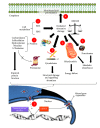Oxidative stress in aging: advances in proteomic approaches
- PMID: 24688629
- PMCID: PMC3943264
- DOI: 10.1155/2014/573208
Oxidative stress in aging: advances in proteomic approaches
Abstract
Aging is a gradual, complex process in which cells, tissues, organs, and the whole organism itself deteriorate in a progressive and irreversible manner that, in the majority of cases, implies pathological conditions that affect the individual's Quality of Life (QOL). Although extensive research efforts in recent years have been made, the anticipation of aging and prophylactic or treatment strategies continue to experience major limitations. In this review, the focus is essentially on the compilation of the advances generated by cellular expression profile analysis through proteomics studies (two-dimensional [2D] electrophoresis and mass spectrometry [MS]), which are currently used as an integral approach to study the aging process. Additionally, the relevance of the oxidative stress factors is discussed. Emphasis is placed on postmitotic tissues, such as neuronal, muscular, and red blood cells, which appear to be those most frequently studied with respect to aging. Additionally, models for the study of aging are discussed in a number of organisms, such as Caenorhabditis elegans, senescence-accelerated probe-8 mice (SAMP8), naked mole-rat (Heterocephalus glaber), and the beagle canine. Proteomic studies in specific tissues and organisms have revealed the extensive involvement of reactive oxygen species (ROS) and oxidative stress in aging.
Figures



References
-
- Hensley K, Floyd RA. Reactive oxygen species and protein oxidation in aging: a look back, a look ahead. Archives of Biochemistry and Biophysics. 2002;397(2):377–383. - PubMed
-
- Imlay JA. Pathways of oxidative damage. Annual Review of Microbiology. 2003;57:395–418. - PubMed
-
- Sohal RS. Role of oxidative stress and protein oxidation in the aging process. Free Radical Biology and Medicine. 2002;33(1):37–44. - PubMed
-
- Merry BJ. Oxidative stress and mitochondrial function with aging—the effects of calorie restriction. Aging Cell. 2004;3(1):7–12. - PubMed
-
- Finkel T, Holbrook NJ. Oxidants, oxidative stress and the biology of ageing. Nature. 2000;408(6809):239–247. - PubMed
Publication types
MeSH terms
LinkOut - more resources
Full Text Sources
Other Literature Sources
Medical

